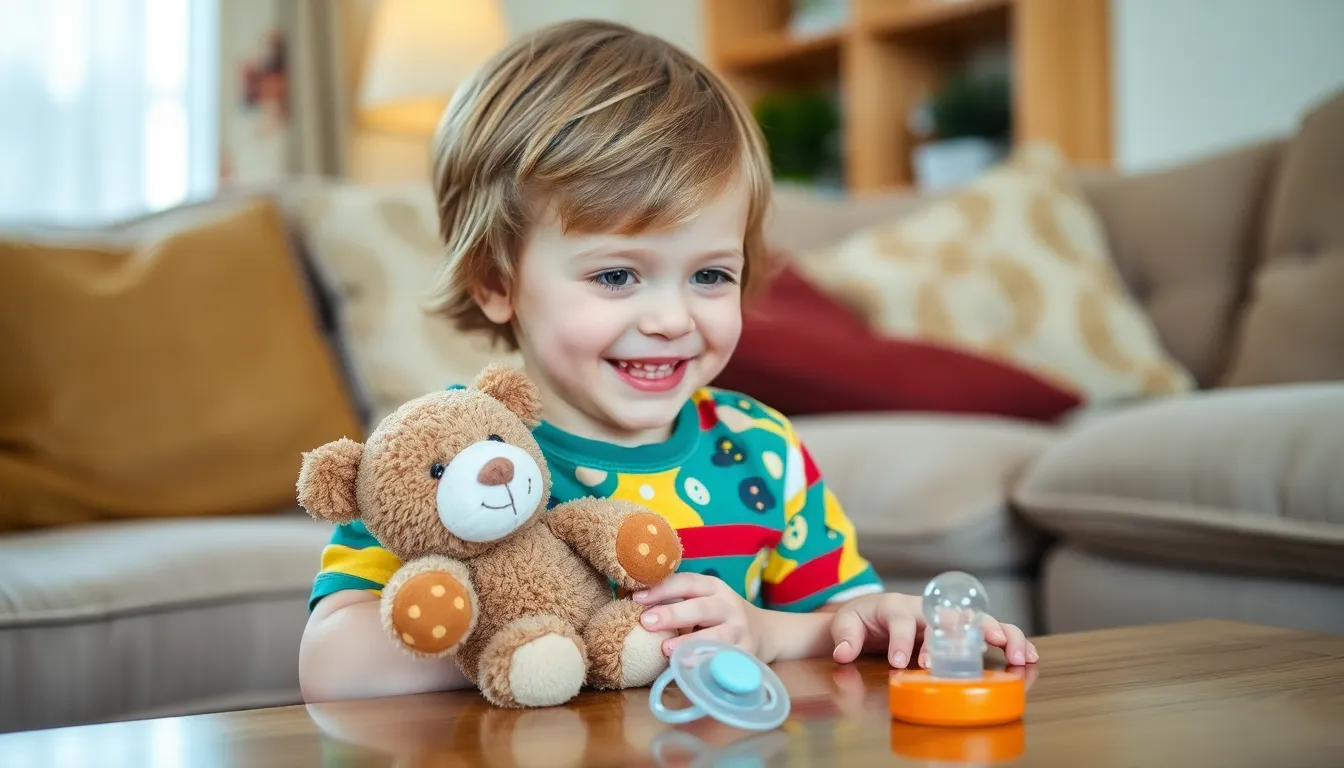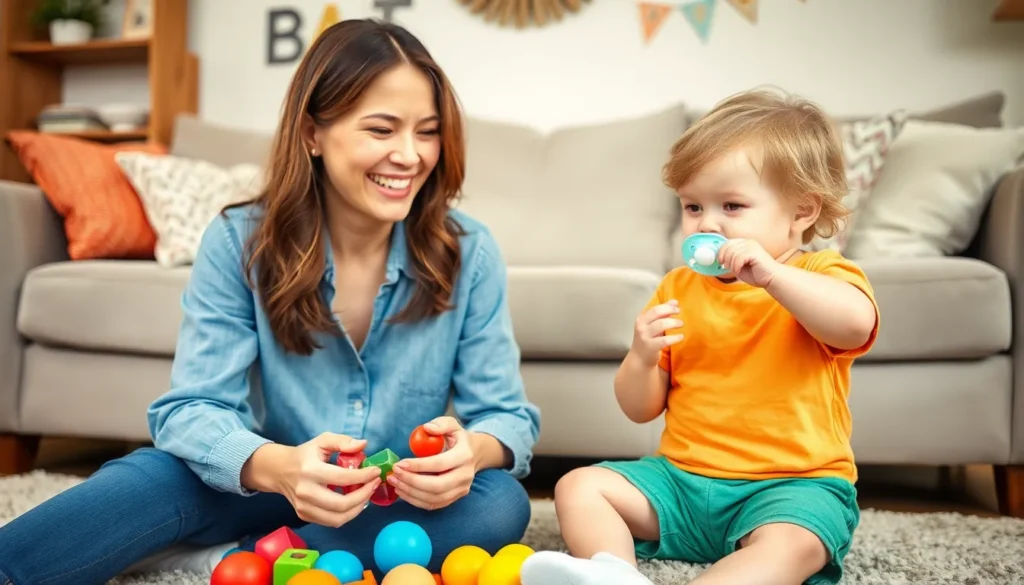Table of Contents
ToggleEvery parent knows the sweet sound of silence that comes from a happy baby with a pacifier. But as those tiny tots grow, the time to say goodbye to the beloved binky inevitably arrives. Pacifier weaning can feel like attempting to negotiate a peace treaty with a tiny tyrant. But fear not! With a sprinkle of patience and a dash of creativity, this transition can be smoother than a well-timed dad joke.
In this guide, parents will discover practical tips and tricks to make pacifier weaning less of a battle and more of a fun adventure. From distraction techniques to alternative comfort items, it’s all about turning that frown upside down. After all, who said saying goodbye to the pacifier can’t come with a few giggles along the way? Get ready to embrace this new chapter with confidence and maybe even a few laughs.
Understanding Pacifier Weaning
Pacifier weaning involves the gradual process of helping children let go of their pacifiers. This change can be essential for their development and helps them transition to new routines.
What Is Pacifier Weaning?
Pacifier weaning refers to the process of reducing or eliminating pacifier use. Parents often embark on this journey when they notice their child relying heavily on pacifiers for comfort. Gradual reduction in usage promotes self-soothing and independence. Timing plays a crucial role, with many caregivers choosing to start between ages two and four. This stage supports speech development and dental health while easing the transition.
Reasons for Pacifier Weaning
Multiple reasons exist for choosing to wean from pacifiers. Health professionals often highlight dental concerns, stating prolonged use may lead to misaligned teeth. Social factors also influence this decision, as children may feel self-conscious about using a pacifier in social settings. Additionally, dependency on pacifiers can hinder a child’s ability to develop coping skills. Parents might choose weaning to encourage independence in their child’s emotional growth. Emphasizing these reasons helps parents embrace the change with confidence.
Signs It’s Time to Wean

Recognizing the right moment for pacifier weaning involves observing specific signs that indicate readiness. These cues can guide the process smoothly while addressing children’s emotional and developmental needs.
Age Recommendations
Most experts recommend starting pacifier weaning between ages two and four. This timeframe aligns with critical developmental milestones, including speech advancement and social interaction. Children at this age typically show increased independence and curiosity. Weaning can enhance their ability to cope without reliance on a pacifier. Pediatricians often suggest evaluating children’s readiness around age two if they exhibit sufficient growth in communication skills. They also highlight the potential dental issues associated with prolonged pacifier use.
Behavioral Indicators
Behavioral signs often indicate it’s time to eliminate the pacifier. Frequent misplacing or forgetting the pacifier throughout the day suggests disinterest. Increased tantrums related to pacifier access may signal an emotional attachment. Children seeking comfort from alternative sources like stuffed animals can mean readiness to wean. Additionally, if a child expresses a desire to imitate peers or older siblings, the time may be right. Parents should also observe if their child engages more in imaginative play without reliance on the pacifier, indicating readiness for this transition.
Effective Weaning Strategies
Pacifier weaning can become smoother through several effective strategies designed to ease the transition. Parents find success with the following methods.
Gradual Reduction
Gradual reduction involves slowly decreasing pacifier use over time. Starting with specific times of day, such as naps or bedtimes, helps the child adjust. After a few days, parents can eliminate another instance, aiming for consistency. Children often adapt more easily when they know what to expect. Over a couple of weeks, this method usually leads to complete weaning without resistance.
Cold Turkey Approach
The cold turkey approach entails stopping pacifier use entirely and immediately. This strategy demands strong resolve from both parents and children. Some parents find it effective since it eliminates confusion over when the pacifier can be used. Providing comfort and reassurance during this time helps ease the emotional stress. Parents may notice increased initial tantrums, but consistency prevails as children adjust over time.
Distraction Techniques
Distraction techniques help shift children’s focus away from the pacifier. Engaging children in playtime activities or creative projects can effectively redirect their attention. Introducing new toys or games captures interest and keeps them occupied. Additionally, offering positive reinforcement, like praise for going without the pacifier, boosts confidence. Incorporating storytime or interactive activities offers comfort during this transition.
Overcoming Challenges
Pacifier weaning can present various challenges for parents and children. Coping with these hurdles requires patience and creativity.
Dealing with Resistance
Resistance often appears during pacifier weaning. Children might cry or throw tantrums when the pacifier is removed. Offering praise for small achievements can encourage compliance. Engaging them in exciting activities diverts attention from the pacifier. Setting clear boundaries helps create understanding. When children see that others are thriving without a pacifier, they may want to follow suit. Consistent conversations about moving on from the pacifier foster acceptance. By maintaining a calm demeanor, parents can soothe their children’s frustrations and make the transition feel less daunting.
Addressing Emotional Responses
Emotional responses frequently arise during weaning. Children may express feelings of sadness or anxiety over losing their pacifier. Validating these emotions shows understanding and support. Providing comfort objects, such as a favorite toy, can ease distress. Transitioning to a new bedtime routine creates a sense of security. Using gentle language during discussions can minimize fear. Stability in other areas of a child’s life contributes to emotional resilience. Encouraging open dialogue allows children to express their feelings. Addressing these emotional aspects builds trust and promotes a smoother transition away from pacifier reliance.
Pacifier weaning is a significant milestone for both parents and children. By approaching this transition with creativity and patience, parents can help their little ones navigate this change more smoothly. Recognizing signs of readiness and employing effective strategies can make the process feel less daunting.
Embracing this journey with humor and understanding not only eases the child’s anxiety but also strengthens the parent-child bond. Ultimately, the goal is to foster independence and emotional resilience, setting the stage for future developmental successes. With the right mindset and tools, pacifier weaning can become a rewarding experience for families.







